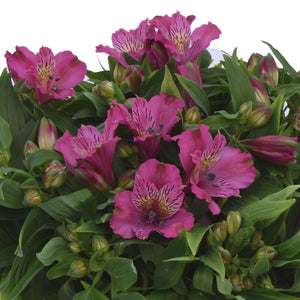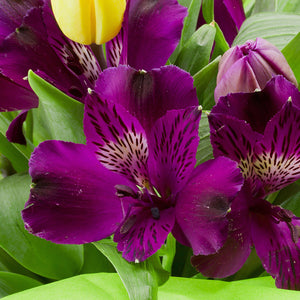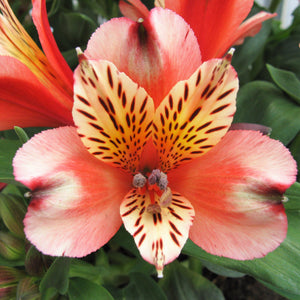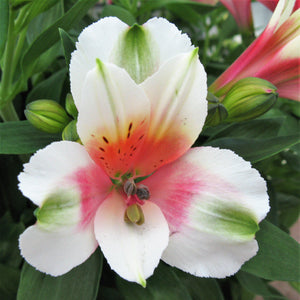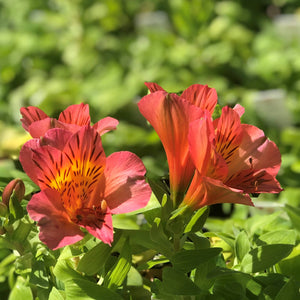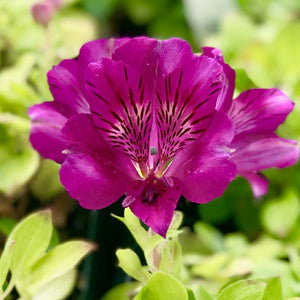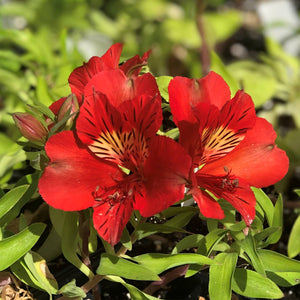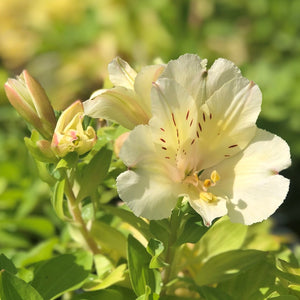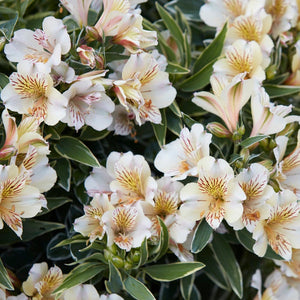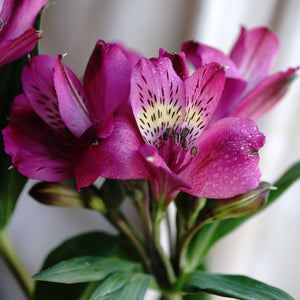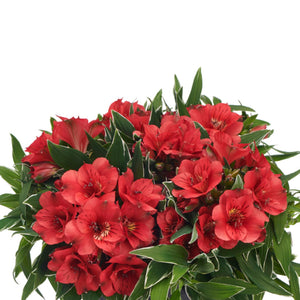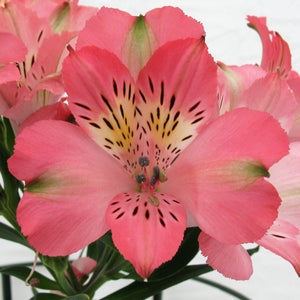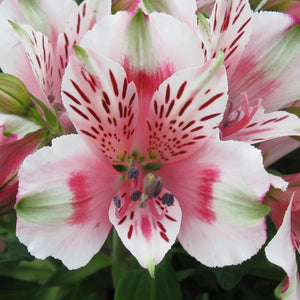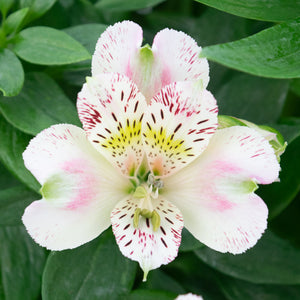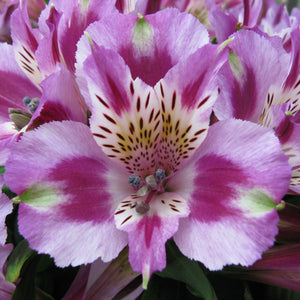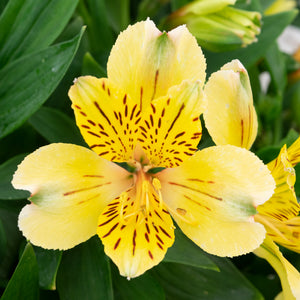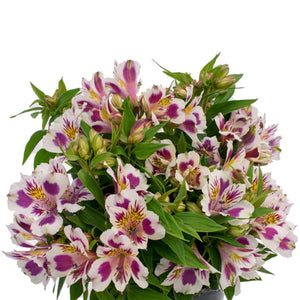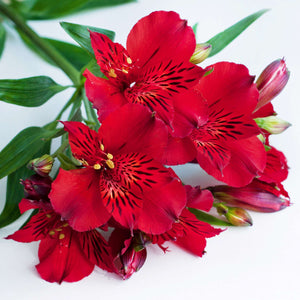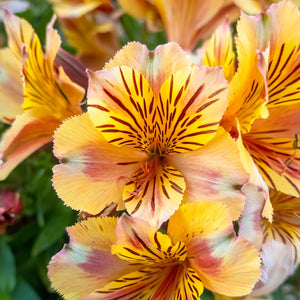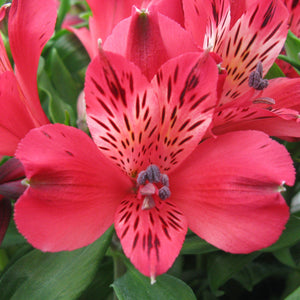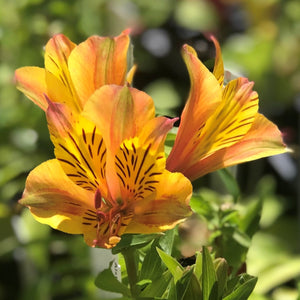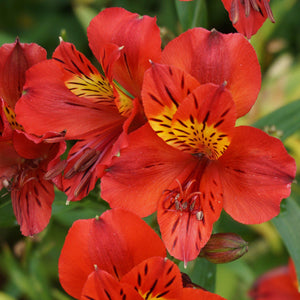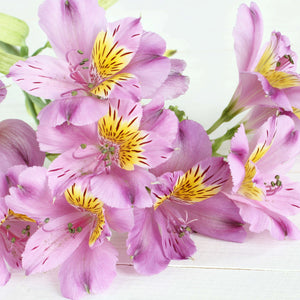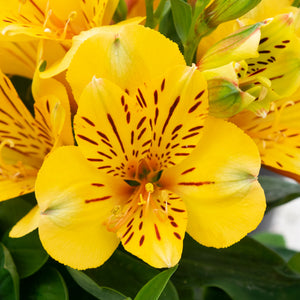- Home
- Planting Guides
- Alstroemeria Planting & Growing Guide
Alstroemeria Planting & Growing Guide
Alstroemeria, also known as Peruvian Lilies or Princess Lilies, are petite plants with lush foliage that produce a wealth of vivid blooms from late spring to early autumn. Not only are these blooms festooned with contrasting shades and endearing whiskers, but they have a sensational vase life of up to two weeks! These happy plants thrive in partial sunny conditions and perform well in garden beds, borders, or containers. Discover how to plant, grow, and care for this prolific bloomer using this comprehensive guide!
Success Snapshot
PLANTING
DEPTH
Pre-Potted

WATER
QUANTITY
Moderate
SUNLIGHT
QUANTITY
Full to Partial Sun
PLANTING
PROXIMITY
18" Apart
BLOOM
SEASON
Early Summer through Fall
HARDINESS
ZONES
Zones 8-10
Shop Related Products
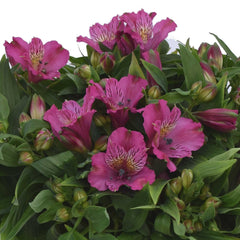
Alstroemeria - Inca Goal 3 Pack
$29.95
Contains: 3 Alstroemeria in 3-4" grower's pots
Botanical Name: Alstroemeria Inca™ 'Goal'
Exposure: Partial Sun; Needs protection from hot sun & temps; Bright filtered light is best
Hardiness: Zones 8-10; Can be Zone 7 with protection; Annual everywhere else; Mulch below 40F or bring inside

Alstroemeria - Inca Noble 3 Pack
$29.95
Contains: 3 Alstroemeria in a 3-4" grower's pots
Botanical Name: Alstroemeria Inca™ 'Noble'
Exposure: Partial Sun; Needs protection from hot sun & temps; Bright filtered light is best
Hardiness: Zones 8-10; Can be Zone 7 with protection; Annual everywhere else; Mulch below 40F or bring inside

Alstroemeria - Inca Husky 3 Pack
$29.95
Contains: 3 Alstroemeria in 3-4" grower's pots
Botanical Name: Alstroemeria Inca™ 'Husky'
Exposure: Partial Sun; Needs protection from hot sun & temps; Bright filtered light is best
Hardiness: Zones 8-10; Can be Zone 7 with protection; Annual everywhere else; Mulch below 40F or bring inside

Alstroemeria - Inca Lucky 3 Pack
$29.95
Contains: 3 Alstroemeria in 3-4" grower's pots
Botanical Name: Alstroemeria Inca™ 'Lucky'
Exposure: Partial Sun; Needs protection from hot sun & temps; Bright filtered light is best
Hardiness: Zones 8-10; Can be Zone 7 with protection; Annual everywhere else; Mulch below 40F or bring inside

Alstroemeria - Colorita Amina 3 Pack
$29.95
Contains: 3 Alstroemeria in 3-4" grower's pots
Botanical Name: Alstroemeria Colorita® 'Amina'
Exposure: Partial Sun; Needs protection from hot sun & temps; Bright filtered light is best
Hardiness: Zones 8-10; Can be Zone 7 with protection; Annual everywhere else; Mulch below 40F or bring inside

Alstroemeria - Colorita Tamara 3 Pack
$29.95
Contains: 3 Alstroemeria in 3-4" grower's pots
Botanical Name: Alstroemeria Colorita® 'Tamara'
Exposure: Partial Sun; Needs protection from hot sun & temps; Bright filtered light is best
Hardiness: Zones 8-10; Can be Zone 7 with protection; Annual everywhere else; Mulch below 40F or bring inside

Alstroemeria - Colorita Kate 3 Pack
$29.95
Contains: 3 Alstroemeria in 3-4" grower's pots
Botanical Name: Alstroemeria Colorita® 'Kate'
Exposure: Partial Sun; Needs protection from hot sun & temps; Bright filtered light is best
Hardiness: Zones 8-10; Can be Zone 7 with protection; Annual everywhere else; Mulch below 40F or bring inside

Alstroemeria - Colorita Claire 3 Pack
$29.95
Contains: 3 Alstroemeria in 3-4" grower's pots
Botanical Name: Alstroemeria Colorita® 'Claire'
Exposure: Partial Sun; Needs protection from hot sun & temps; Bright filtered light is best
Hardiness: Zones 8-10; Can be Zone 7 with protection; Annual everywhere else; Mulch below 40F or bring inside

Alstroemeria - Colorita Fabiana 3 Pack
$29.95
Contains: 3 Alstroemeria in 3-4" grower's pots
Botanical Name: Alstroemeria Colorita® 'Fabiana'
Exposure: Partial Sun; Needs protection from hot sun & temps; Bright filtered light is best
Hardiness: Zones 8-10; Can be Zone 7 with protection; Annual everywhere else; Mulch below 40F or bring inside

Alstroemeria - Colorita Louise 3 Pack
$29.95
Contains: 3 Alstroemeria in 3-4" grower's pots
Botanical Name: Alstroemeria Colorita® 'Louise'
Exposure: Partial Sun; Needs protection from hot sun & temps; Bright filtered light is best
Hardiness: Zones 8-10; Can be Zone 7 with protection; Annual everywhere else; Mulch below 40F or bring inside

Alstroemeria - Colorita Katiana 3 Pack
$29.95
Contains: 3 Alstroemeria in 3-4" grower's pots
Botanical Name: Alstroemeria Colorita® 'Katiana'
Exposure: Partial Sun; Needs protection from hot sun & temps; Bright filtered light is best
Hardiness: Zones 8-10; Can be Zone 7 with protection; Annual everywhere else; Mulch below 40F or bring inside

Alstroemeria - Inca Coral 3 Pack
$29.95
Contains: 3 Alstroemeria in 3-4" grower's pots
Botanical Name: Alstroemeria Inca™ 'Coral'
Exposure: Partial Sun; Needs protection from hot sun & temps; Bright filtered light is best
Hardiness: Zones 8-10; Can be Zone 7 with protection; Annual everywhere else; Mulch below 40F or bring inside

Alstroemeria - Inca Toto 3 Pack
$29.95
Contains: 3 Alstroemeria in 3-4" grower's pots
Botanical Name: Alstroemeria Inca™ 'Toto'
Exposure: Partial Sun; Needs protection from hot sun & temps; Bright filtered light is best
Hardiness: Zones 8-10; Can be Zone 7 with protection; Annual everywhere else; Mulch below 40F or bring inside
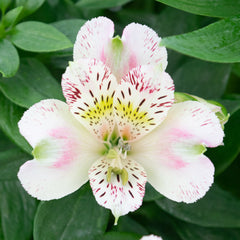
Alstroemeria - Inca Vienna 3 Pack
$29.95
Contains: 3 Alstroemeria in 3-4" grower's pots
Botanical Name: Alstroemeria Inca™ 'Vienna'
Exposure: Partial Sun; Needs protection from hot sun & temps; Bright filtered light is best
Hardiness: Zones 8-10; Can be Zone 7 with protection; Annual everywhere else; Mulch below 40F or bring inside
Alstroemeria - Inca Sundance 3 Pack
$29.95
Contains: 3 Alstroemeria in 3-4" grower's pots
Botanical Name: Alstroemeria Inca™ 'Sundance'
Exposure: Partial Sun; Needs protection from hot sun & temps; Bright filtered light is best
Hardiness: Zones 8-10; Can be Zone 7 with protection; Annual everywhere else; Mulch below 40F or bring inside
Alstroemeria - Inca Reef 3 Pack
$29.95
Contains: 3 Alstroemeria in 3-4" grower's pots
Botanical Name: Alstroemeria Inca™ 'Reef'
Exposure: Partial Sun; Needs protection from hot sun & temps; Bright filtered light is best
Hardiness: Zones 8-10; Can be Zone 7 with protection; Annual everywhere else; Mulch below 40F or bring inside

Alstroemeria - Inca Mystic 3 Pack
$29.95
Contains: 3 Alstroemeria in 3-4" grower's pots
Botanical Name: Alstroemeria Inca™ 'Mystic'
Exposure: Partial Sun; Needs protection from hot sun & temps; Bright filtered light is best
Hardiness: Zones 8-10; Can be Zone 7 with protection; Annual everywhere else; Mulch below 40F or bring inside
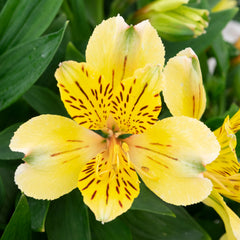
Alstroemeria - Inca Gold Rush 3 Pack
$29.95
Contains: 3 Alstroemeria in 3-4" grower's pots
Botanical Name: Alstroemeria Inca™ 'Gold Rush'
Exposure: Partial Sun; Needs protection from hot sun & temps; Bright filtered light is best
Hardiness: Zones 8-10; Can be Zone 7 with protection; Annual everywhere else; Mulch below 40F or bring inside

Alstroemeria - Inca Magic 3 Pack
$29.95
Contains: 3 Alstroemeria in 3-4" grower's pots
Botanical Name: Alstroemeria Inca™ 'Magic'
Exposure: Partial Sun; Needs protection from hot sun & temps; Bright filtered light is best
Hardiness: Zones 8-10; Can be Zone 7 with protection; Annual everywhere else; Mulch below 40F or bring inside

Alstroemeria - Inca Bandit 3 Pack
$29.95
Contains: 3 Alstroemeria in 3-4" grower's pots
Botanical Name: Alstroemeria Inca™ 'Bandit'
Exposure: Partial Sun; Needs protection from hot sun & temps; Bright filtered light is best
Hardiness: Zones 8-10; Can be Zone 7 with protection; Annual everywhere else; Mulch below 40F or bring inside

Alstroemeria - Colorita Sara 3 Pack
$29.95
Contains: 3 Alstroemeria in 3-4" grower's pots
Botanical Name: Alstroemeria Colorita® 'Sara'
Exposure: Partial Sun; Needs protection from hot sun & temps; Bright filtered light is best
Hardiness: Zones 8-10; Can be Zone 7 with protection; Annual everywhere else; Mulch below 40F or bring inside
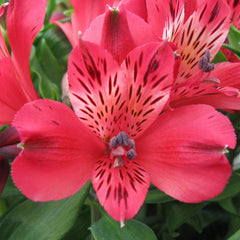
Alstroemeria - Inca Lolly 3 Pack
$29.95
Contains: 3 Alstroemeria in 3-4" grower's pots
Botanical Name: Alstroemeria Inca™ 'Lolly'
Exposure: Partial Sun; Needs protection from hot sun & temps; Bright filtered light is best
Hardiness: Zones 8-10; Can be Zone 7 with protection; Annual everywhere else; Mulch below 40F or bring inside

Alstroemeria - Colorita Diana 3 Pack
$29.95
Contains: 3 Alstroemeria in 3-4" grower's pots
Botanical Name: Alstroemeria Colorita® 'Diana'
Exposure: Partial Sun; Needs protection from hot sun & temps; Bright filtered light is best
Hardiness: Zones 8-10; Can be Zone 7 with protection; Annual everywhere else; Mulch below 40F or bring inside

Alstroemeria - Inca Vito 3 Pack
$29.95
Contains: 3 Alstroemeria in 3-4" grower's pots
Botanical Name: Alstroemeria Inca™ 'Vito'
Exposure: Partial Sun; Needs protection from hot sun & temps; Bright filtered light is best
Hardiness: Zones 8-10; Can be Zone 7 with protection; Annual everywhere else; Mulch below 40F or bring inside

Alstroemeria - Inca Lake 3 Pack
$29.95
Contains: 3 Alstroemeria in 3-4" grower's pots
Botanical Name: Alstroemeria Inca™ 'Lake'
Exposure: Partial Sun; Needs protection from hot sun & temps; Bright filtered light is best
Hardiness: Zones 8-10; Can be Zone 7 with protection; Annual everywhere else; Mulch below 40F or bring inside
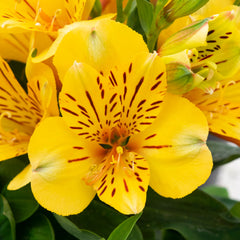
Alstroemeria - Inca Rio 3 Pack
$29.95
Contains: 3 Alstroemeria in 3-4" grower's pots
Botanical Name: Alstroemeria Inca™ 'Rio'
Exposure: Partial Sun; Needs protection from hot sun & temps; Bright filtered light is best
Hardiness: Zones 8-10; Can be Zone 7 with protection; Annual everywhere else; Mulch below 40F or bring inside
Where to Plant
Alstroemeria plants appreciate sites with well-drained soil and plenty of sunlight. These prolific perennials aren't fussy about soil, but they will not survive in soggy conditions or standing water. Therefore, if you're using containers, make sure there are adequate drainage holes. Also, if you're planting outdoors and notice water puddles 5–6 hours after a hard rain, you'll want to find another site or amend the soil with the addition of organic material to improve drainage.
When to Plant
Alstroemeria should be planted in the spring, early summer, or fall, depending on your climate. The ideal time to plant is when temperatures do not exceed 68° F and range between 40 and 50° F. If growing indoors, you can do so anytime as long as your Alstroemeria is in a temperate location.
How to Plant
- For outdoor landscape planting, find a location where the soil drains well, and your Alstroemeria will receive full-day or lightly filtered sunshine. Dig holes and nestle the plants so that the soil level on the root ball from the nursery pot is even with your garden soil. Press the soil down to secure the plant.
- For container planting, fill the containers with good quality, well-drained soil. Almost any commercially available potting medium will do the trick. Tuck the plants in so that the soil level on the root ball from the nursery pot is even with the soil level in the container. Press the soil down around the roots to secure the plant.
- Water generously after planting to settle the soil around the root ball.
How to Grow
- Water as needed during active growth, bearing in mind that Alstroemeria plants tend to be a bit thirsty and produce the greatest number of flowers when given generous amounts of water. During the winter, water lightly as you allow your plant to rest for a few months before starting the next growing cycle.
- Fertilize your Alstroemeria plant with a high potassium fertilizer each week during the growing season.
- Protect Alstroemeria in zone 7B gardens during the winter with a 3–4" layer of leaves or pine needles. Alstroemeria are winter hardy in zones 8–10 and shouldn’t require protection there.
- Bring Alstroemeria plants indoors in the winter in colder areas. Place near a sunny window, and don't be concerned if a few leaves fall off as your plant adjusts to an indoor environment.
- Move your Alstroemeria outdoors again when the weather warms. Remember, the nights must be warm, too, before relocating your plants outdoors.
Alstroemeria Tips & Tricks:
- Amend soil with compost, finely ground bark, or composted manure as needed to avoid waterlogging your plant.
- Plant in warm soil, and if the soil is still quite cool, start indoors in containers and move the plants outdoors when the weather warms.
- Water plants in terra cotta pots more frequently as they lose water through evaporation across their entire surface.
- Keep soil temperatures as warm and consistent as possible when keeping your plant outdoors year-round by applying a 3” layer of mulch around the plant.
- Pick flowers from the base rather than cut them, as cutting causes the underground meristems to die.
- Deadhead spent flowers if you want to prevent your Alstroemeria from multiplying too much via self-seeding.

